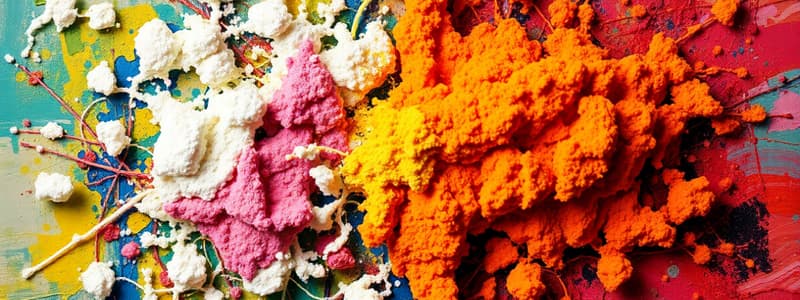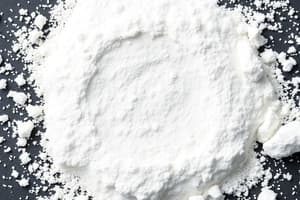Podcast
Questions and Answers
Which of the following is an example of a homogeneous mixture?
Which of the following is an example of a homogeneous mixture?
- Sugar solution (correct)
- Fruit salad
- Sand and sugar
- Sea water
What is a defining characteristic of a pure substance?
What is a defining characteristic of a pure substance?
- It has a variable composition.
- It exhibits heterogeneous properties.
- It consists of only one kind of particle. (correct)
- It can be separated into components by physical methods.
What type of mixture contains components that do not have the same composition throughout?
What type of mixture contains components that do not have the same composition throughout?
- Solution
- Solid solution
- Homogeneous mixture
- Heterogeneous mixture (correct)
Which of these mixtures can be classified as a liquid homogeneous mixture?
Which of these mixtures can be classified as a liquid homogeneous mixture?
Which statement is true regarding impure substances?
Which statement is true regarding impure substances?
What type of mixture would smoke in air be classified as?
What type of mixture would smoke in air be classified as?
What is a characteristic of mixtures compared to pure substances?
What is a characteristic of mixtures compared to pure substances?
Which of the following is NOT an example of a mixture?
Which of the following is NOT an example of a mixture?
What defines a substance in the context of mixtures?
What defines a substance in the context of mixtures?
Which of the following properties is characteristic of a solution?
Which of the following properties is characteristic of a solution?
Which term describes the mixture consisting of two phases: dispersed phase and dispersion medium?
Which term describes the mixture consisting of two phases: dispersed phase and dispersion medium?
What is a key feature that distinguishes a suspension from a solution?
What is a key feature that distinguishes a suspension from a solution?
Which of the following solutions has solute particles ranging between 1 nm to 100 nm?
Which of the following solutions has solute particles ranging between 1 nm to 100 nm?
What characteristic feature is observed in suspensions that does not occur in solutions?
What characteristic feature is observed in suspensions that does not occur in solutions?
Which component of a solution dissolves the other component?
Which component of a solution dissolves the other component?
Which of the following examples illustrates colloidal solutions?
Which of the following examples illustrates colloidal solutions?
Which of the following statements about colloidal solutions is NOT true?
Which of the following statements about colloidal solutions is NOT true?
What is the Tyndall effect?
What is the Tyndall effect?
Which method can be used to separate cream from milk?
Which method can be used to separate cream from milk?
Which classification belongs to the type of colloidal solutions?
Which classification belongs to the type of colloidal solutions?
What property of colloidal solutions allows them to maintain their state without sedimentation?
What property of colloidal solutions allows them to maintain their state without sedimentation?
Which of the following processes is NOT suitable for separating a solid from a liquid?
Which of the following processes is NOT suitable for separating a solid from a liquid?
What is NOT a characteristic of colloidal particles?
What is NOT a characteristic of colloidal particles?
In which process does a liquid change to a gas without reaching its boiling point?
In which process does a liquid change to a gas without reaching its boiling point?
Which of the following is an example of a sublimable solid?
Which of the following is an example of a sublimable solid?
What principle does chromatography operate on?
What principle does chromatography operate on?
What is the main purpose of distillation?
What is the main purpose of distillation?
Fractional distillation is particularly useful when separating liquids with boiling point differences of less than how many Kelvin?
Fractional distillation is particularly useful when separating liquids with boiling point differences of less than how many Kelvin?
Which of the following describes crystallization?
Which of the following describes crystallization?
What is a defining characteristic of a chemical change?
What is a defining characteristic of a chemical change?
Elements can be classified into which of the following categories?
Elements can be classified into which of the following categories?
What does a chemical formula represent?
What does a chemical formula represent?
Flashcards are hidden until you start studying
Study Notes
Pure Substances
- Defined as substances made up of only one type of particle, either atoms or molecules.
- Examples include water, sulfur, hydrogen, and carbon.
- Possess fixed composition, melting point, and boiling point.
Impure Substances
- Composed of two or more different kinds of particles.
- Separable by physical methods; includes all mixtures.
- Examples: salt solution, milk, air, and soft drinks.
- Do not have fixed composition or consistent melting/boiling points.
Mixtures
- Mixtures consist of multiple elements or compounds mixed without forming new compounds.
- Properties resemble the constituents, highlighting variability in composition.
- Can be classified as homogeneous or heterogeneous.
Homogeneous Mixtures
- Features a single phase with uniform composition throughout.
- No visible separation between components.
- Examples: sugar solution, vinegar, alloy mixtures.
Heterogeneous Mixtures
- Composed of multiple phases; visible separation between components.
- Inconsistent composition throughout.
- Examples: sand and sugar mixture, water with chalk, smoke in air.
Solutions
- A type of homogeneous mixture where a solvent dissolves a solute.
- Characteristics: particles are tiny and not visible, light path is not visible, cannot be separated by filtration.
Suspension
- A heterogeneous mixture of solids and liquids.
- Solid particles are suspended and can be seen with the naked eye; they settle over time.
- Can be separated by filtration; example: sand in water.
Colloids
- A heterogeneous mixture with particle sizes intermediate between solutions and suspensions (1 nm to 100 nm).
- Appears homogeneous but contains two distinct phases: dispersed phase and dispersion medium.
- Examples: milk, toothpaste, and ink.
- Characteristics include charge on particles and zigzag movement (Brownian motion).
Tyndall Effect
- Phenomenon where light is scattered by suspended particles, visible in colloidal solutions.
Separation Techniques
- Evaporation: Extracts solute (e.g., salt) from a solution by converting liquid to gas.
- Filtration: Differentiates solids from liquids through a filter.
- Centrifugation: Uses spinning to separate denser particles from lighter ones.
- Separating Funnel: Distinguishes immiscible liquids based on density differences.
- Sublimation: Converts solids directly to gas, separating volatile components from non-volatile impurities.
- Chromatography: Separates substances based on solubility in a solvent.
- Distillation: Separates liquids based on boiling point differences; useful for water purification.
- Fractional Distillation: Separates components with boiling point differences under 25K.
- Crystallization: Forms large crystals from solutions, aids in purifying substances.
Classification of Pure Substances
- Elements: Basic forms of matter that cannot be simplified by chemical reactions. Includes metals, non-metals, metalloids, and noble gases.
- Compounds: Formed through chemical combinations of two or more elements in fixed proportions.
Chemical Changes
- Involve alterations in the chemical composition of substances.
- Result in new substances that are not easily reversible.
- Associated with energy changes during the transformation.
Chemical Formula
- A symbolic representation that conveys the composition of a chemical compound.
Studying That Suits You
Use AI to generate personalized quizzes and flashcards to suit your learning preferences.



